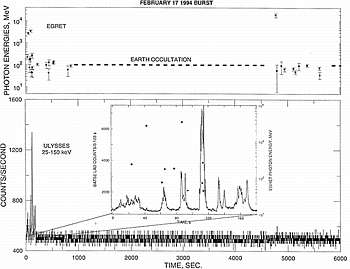
If bursts are truly at cosmological distances, they would be generated in the most energetic explosions in the universe. The strongest lines of evidence in favor of a galactic neutron star origin were i) rapid time variability; ;ii) the observations of absorption and emission lines in the spectra of bursts, interpreted as cyclotron resonance scattering and e+/e- annihilation; and iii) the evolution of burst continuum spectra to and from a blackbody shape, consistent with a ratio of emitting region size to source distance of 1 km/1 kpc.

Figure 2.5.2 - 17 Feb 1994 burst with EGRET high-energy photons.
The most important question to be answered about bursts is their distance scale. There are many different ways of addressing this question: detection of a counterpart; confirmation of cyclotron absorption or positron-electron emission features; confirmation of a repeating classical GRB source; confirmation of a redshift-luminosity relation, or time dilation; detection of a radio signal dispersed in time, associated with a GRB; detection of a gravitationally lensed burst; detection of a coincident neutrino burst; detection of a coincident burst of gravitational radiation; detection of TeV emission from a burst; study of low-energy (< 1 keV) photoelectric absorption in the spectra of bursts; detection of a soft X-ray scattering halo around a GRB source; detection of absorption edges in the low-energy spectra of bursts; detection of an excess of bursts from a nearby galaxy or cluster of galaxies; detection of an excess of bursts from a nearby star (e.g., Oort cloud origin); detection of afterglows due to interactions of gamma radiation with the medium surrounding the source. For each of these, it is important to consider not only what a positive result would tell us, but also, how a negative result would constrain the available phase space. For example, not all progenitors are expected to have readily detectable counterparts. Counterparts may be characterized by i) the timescale after the burst, i.e., flaring, fading, and quiescent counterparts, and ii) the energy range (e.g., X-ray, UV, optical, IR, and radio). In the resulting matrix of possibilities, fading and quiescent counterparts are expected for most distance scales. Recently, one compelling example of associated transient X-ray and optical sources has emerged-but information is sketchy and many more examples are needed. But even the non-detection of quiescent counterparts has interesting consequences. For example, the lack of bright galaxies in numerous error boxes down to limiting magnitudes mR < 19.5 implies that if these burst sources are in galaxies at cosmological distances, then they must be at distances >1 Gpc (in which case their intrinsic energies exceed 1052 erg, the canonical value for merging neutron stars) or they must be associated with subluminous galaxies. But this negative result does not hold for all error boxes, and does not prove that burst sources are not cosmological. Arcsecond-size error boxes will be needed to perform the definitive test. BATSE, the most sensitive instrument flown to date, has not detected an excess of bursts from Andromeda. Such an excess might be expected if bursts originated in an extended galactic halo. But it can be shown that this result only constrains certain "dark matter" halo models, leaving open the possibility of, for example, exponential halos, which could never be detected by BATSE in the direction of Andromeda. Again, this negative result does not demonstrate conclusively that burst sources are not in the galactic halo. More sensitive experiments are required for this technique. It is entirely possible that the answer to the distance scale question will not come from a study of the conventional gamma-ray properties of bursts. For example, the detection of TeV emission from a burst would argue strongly against a cosmological origin, because TeV photons should be attenuated by intergalactic IR radiation. Another distance indicator might be the low-energy (sub-keV) spectra of bursts. If the photoelectric absorption of this portion of the spectrum, due to the column density between the source and the observer, could be detected, it could distinguish between various models.